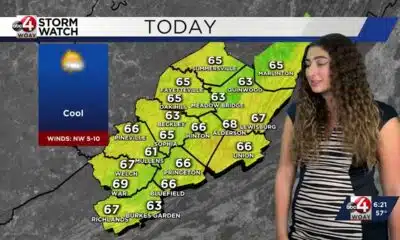News from the South - Texas News Feed
Measles hits adults hardest in El Paso
In El Paso, measles is infecting more adults than children
“In El Paso, measles is infecting more adults than children” was first published by The Texas Tribune, a nonprofit, nonpartisan media organization that informs Texans — and engages with them — about public policy, politics, government and statewide issues.
Sign up for The Brief, The Texas Tribune’s daily newsletter that keeps readers up to speed on the most essential Texas news.
As soon as measles started spreading in West Texas, El Paso health officials began preparing schools and day care facilities for the day the virus would inevitably arrive.
But now that it’s here, it’s not kids who are making up the brunt of the cases — it’s adults. Two-thirds of El Paso’s cases so far are among people over the age of 18, and only 7% are among school-age children.
Anyone unvaccinated can contract measles, but it tends to hit children first and hardest. Most children are not fully vaccinated until they are five years old and they spend more time than adults in congregate settings where the virus can spread quickly. More families of young children are opting out of vaccines, leaving them exposed.
Gaines County, the epicenter of the outbreak, followed this traditional path, starting with school-age children before spreading to adults. Almost six months into what is now the country’s largest measles outbreak since 2000, Texas’ 722 cases are about evenly spread between the three age groups the state divides them into: under four, 5-17 and adults.
El Paso stands out for its high rate of adult infections. The county only has 56 cases so far, the third-highest among Texas counties but still too small of a sample size to conclude much, public health experts say. But if this trend holds, it may be a credit to El Paso’s high vaccination rates among kids — 96% of kindergartners and 98% of seventh graders are fully vaccinated for measles, higher than the percent required to maintain herd immunity. The state does not track adult vaccination rates.
“That is one of the protective factors that we feel is helping us,” said El Paso public health authority Hector Ocaranza. “But still we’re going to continue to see cases of measles that are going to be clustering in some of the schools or day cares that have low immunization rates.”
These surprising initial statistics have required public health officials to change their outbreak response on the fly. They’re aiming more of their vaccination events specifically at adults, especially as many health care providers who serve adults do not have the measles-mumps-rubella vaccine on hand the way pediatricians do.
“Most of the adults, they don’t remember whether they’ve had the MMR vaccine,” Ocaranza said. “They were kids, and nobody has a shot record.”
Adults unsure of whether they were vaccinated as children can safely get another round of the shots, said Patsy Stinchfield, past president of the National Foundation for Infectious Diseases and a measles expert.
“If you did have two [shots] already, it will only make your full antibody cup even fuller,” Stinchfield said.
Older adults especially should consult with their doctor about their immunization status, she said. People born before 1957 are presumed immune, since the virus was so common back then, but some people who got an early version of the vaccine between 1963 and 1967 may not have gotten the same protection as later shots.
The exceptions, she said, are people who are immunocompromised, pregnant women or the tiny minority of people who have had a bad reaction to the vaccine in the past. Those people are counting on everyone else’s vaccination status to keep them healthy.
Healthy adults are generally able to fight off the worst of a measles infection, but anyone who gets infected runs the risk of it morphing into pneumonia or worse, said Ben Neuman, a virologist at Texas A&M University. Three of the five hospitalizations in El Paso so far are in adults.
And anyone with measles will spread it in the community, potentially to children too young to be vaccinated who are especially vulnerable to the worst outcomes, like encephalitis, deafness, blindness and permanent brain damage.
“Especially kids two years and under, their immune systems are just bad at everything,” Neuman said. “We’re all sort of helping them out with our herd immunity.”
Neuman said it’s possible that El Paso’s high rate of adult cases is “the first sign of something weird,” but he anticipates the data will start to look more normal as more people get tested.
El Paso borders the Mexican state of Chihuahua, where the outbreak that originated in Texas has taken hold due to the large Mennonite communities in both places. Ocaranza said measles doesn’t respect borders, and he anticipates it spreading vociferously on both sides of the U.S.-Mexico line now that it’s in El Paso.
The messaging is the same, whether it’s children or adults who are testing positive, in Mexico or the United States, he said: Get vaccinated.
“We welcome anybody who needs the vaccine,” he said. “We can vaccinate regardless of their place of residence, regardless of their immigration status, regardless of the ability to pay … Everyone needs to join forces to stop this.”
Disclosure: Texas A&M University has been a financial supporter of The Texas Tribune, a nonprofit, nonpartisan news organization that is funded in part by donations from members, foundations and corporate sponsors. Financial supporters play no role in the Tribune’s journalism. Find a complete list of them here.
First round of TribFest speakers announced! Pulitzer Prize-winning columnist Maureen Dowd; U.S. Rep. Tony Gonzales, R-San Antonio; Fort Worth Mayor Mattie Parker; U.S. Sen. Adam Schiff, D-California; and U.S. Rep. Jasmine Crockett, D-Dallas are taking the stage Nov. 13–15 in Austin. Get your tickets today!
This article originally appeared in The Texas Tribune at https://www.texastribune.org/2025/05/21/texas-el-paso-measles/.
The Texas Tribune is a member-supported, nonpartisan newsroom informing and engaging Texans on state politics and policy. Learn more at texastribune.org.
The post Measles hits adults hardest in El Paso appeared first on feeds.texastribune.org
Note: The following A.I. based commentary is not part of the original article, reproduced above, but is offered in the hopes that it will promote greater media literacy and critical thinking, by making any potential bias more visible to the reader –Staff Editor.
Political Bias Rating: Centrist
The article is largely focused on a public health issue—measles outbreaks in El Paso—offering a factual account of the situation and the local response. The language is neutral, presenting statements from health officials, medical experts, and public health data without introducing any political or ideological perspectives. The inclusion of both local and expert opinions further emphasizes the aim to inform rather than advocate for a particular viewpoint. Additionally, the article adheres to a non-partisan stance, highlighting health measures and facts while avoiding politically charged language or policy endorsements.
News from the South - Texas News Feed
It's a love story: Taylor Swift, Travis Kelce announce engagement
SUMMARY: Taylor Swift and Kansas City Chiefs tight end Travis Kelce are engaged, announcing it on Instagram with a photo of Kelce proposing in a garden and showcasing Swift’s dazzling “Old Mine brilliant cut” ring. The couple, both 35, began dating in 2023 after Kelce attended Swift’s Eras Tour. Despite early challenges, including Kelce’s unsuccessful attempt to give Swift a friendship bracelet with his number, their relationship blossomed. Swift has supported Kelce at numerous games, including two Super Bowls, while Kelce frequently attends her concerts. Their relationship has garnered massive media attention and was featured in ESPN’s documentary “The Kingdom.” Kelce’s parents praise their bond as genuine and deserving.
The post It's a love story: Taylor Swift, Travis Kelce announce engagement appeared first on www.kxan.com
News from the South - Texas News Feed
We're excited for National Dog Day!
SUMMARY: To celebrate National Dog Day, the studio welcomed three dogs: Mac, Sandy, and Leo. Sandy sports a playful lipstick kiss from Kim Castro, while lively one-year-old Leo kept everyone entertained. The dogs’ owners, also producers, shared that it’s usually breakfast, walk, or nap time for them. The studio enjoyed the furry therapy vibe and encouraged viewers to treat their dogs with special offers from PetSmart (buy one, get one 25% off on treats), Lazy Dog Restaurant and Bar (coupon with dog bowl and entree), and free Puppuccinos from Starbucks. Viewer-submitted dog photos added to the joyful celebration of our furry friends.
We had in-studio guests to help us celebrate.
News from the South - Texas News Feed
'Bathroom bill' advances in Texas House days after tensions flared at hearing
SUMMARY: A Texas House panel approved Senate Bill 8, limiting transgender people’s use of bathrooms in government buildings, marking the first House advancement of a “bathroom bill” in over eight years. The bill, backed by Gov. Greg Abbott, passed 9-3 in committee and now heads to the House floor. SB 8 imposes penalties on institutions allowing restroom use not matching sex assigned at birth and extends restrictions to schools, universities, shelters, prisons, and jails. Opponents warn it promotes harassment and violence, while supporters cite protection of women and children. The bill includes measures to shield it from legal challenges. Lawmakers must pass bills by Sept. 13.
The post 'Bathroom bill' advances in Texas House days after tensions flared at hearing appeared first on www.kxan.com
-
News from the South - Alabama News Feed7 days ago
U.S. agriculture secretary announces end to subsidies for solar panels on farmland
-
News from the South - Kentucky News Feed6 days ago
First of its kind clinical trial offers new hope for Kentuckians at risk of dementia
-
News from the South - Arkansas News Feed7 days ago
Cities across the US are embracing AI guidelines for local government workers
-
News from the South - Alabama News Feed6 days ago
Grants to boost local emergency alert systems in question as public media agency closes
-
Our Mississippi Home6 days ago
MSU Unveils Mixed-Use Development Featuring Boutique Hotel, Cultural Landmark
-
News from the South - Arkansas News Feed6 days ago
‘Alligator Alcatraz’ probed by Dems as ICE detention centers multiply in states
-
News from the South - Arkansas News Feed5 days ago
New I-55 bridge between Arkansas, Tennessee named after region’s three ‘Kings’
-
News from the South - West Virginia News Feed6 days ago
WV groups call on Morrisey, McCuskey to push against end of federal solar program










































